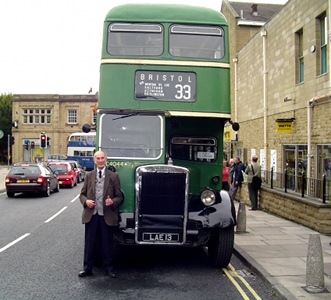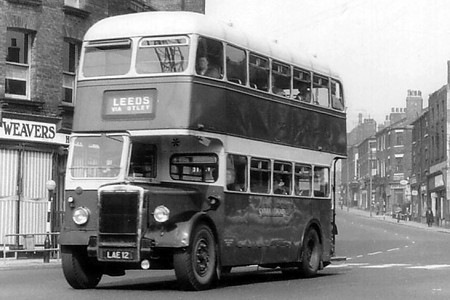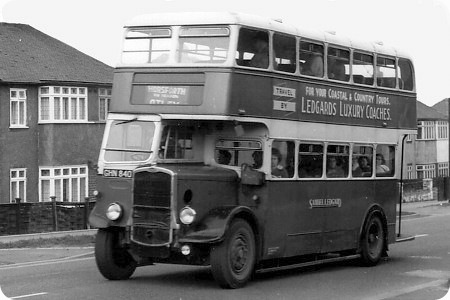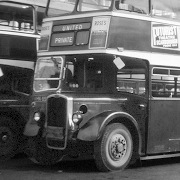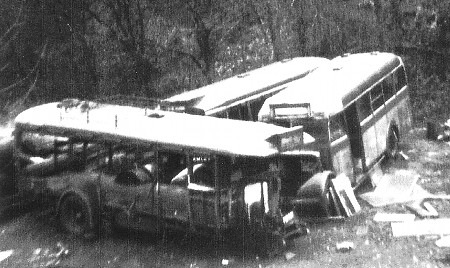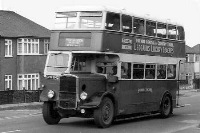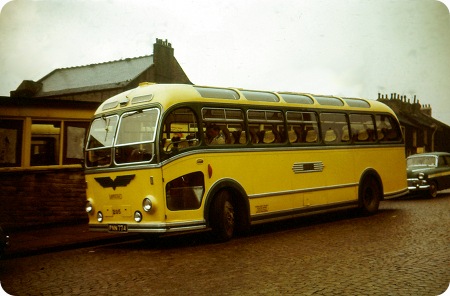Bristol Omnibus – Leyland PD1/A – LAE 13 – C4044
Bristol Omnibus
1947
Leyland PD1/A
ECW H30/26R
Chris Youhill has mentioned that Samuel Ledgard bought and ran a few of these vehicles in the early 1960’s, which prompted me to rummage around and find this photo, which I took at the Bristol Bus Rally in 1977. I don’t believe that LAE 13 was a Ledgard vehicle, although LAE 12 was.
This unusual chassis/body combination arose because of Bristol Tramways Motor Constructional Works’ inability to meet the urgent post-war demands for Bristol chassis. So, fifty Leyland chassis were bought to fill the gap and keep the ECW production line going. Their contemporary high-bridge body was fitted. They did look very high!
One other member (C4019) of the 50 has survived, just, and is slowly being restored.
Photograph and Copy contributed by Chris Hebbron
You couldn’t get any nearer than this to turning the clock back could you ?? Below is another picture of LAE 13 and yours truly, taken on October 14th 2007 on the occasion of the Running Day to commemorate the fortieth anniversary of the demise of the Samuel Ledgard undertaking. The very appropriate location is at Otley Bus Station and LAE 12 which Chris H mentions was stationed at Otley depot throughout its Ledgard career. It was also the bus which I had for my very first duty as a driver – a wickedly busy late turn starting in the peak period on a Friday – and although I was naturally suffering from "stage fright" the wonderful vehicle behaved like a dream, "pulled like a trooper", and kept any of my errors in engine revs and road speed completely quiet and not even a click was heard by the passengers. Here also is a picture of "the real LAE 12" in Leeds. I was already a dedicated Leyland PD1 fan and that Friday was one of the happiest days of my life. The Running Day was also exactly fifty years after I started as a young conductor and so to be able to stand with a vehicle as near as is possible to its memorable twin meant everything to me.
Chris Youhill
Delighted to see the Bristol/Sammy Ledgard PD1, which reminds me of early post war Tilling Group policy.
I believe 100 PD1s were purchased, and spread out among several fleets, including some others with highbridge bodies at Eastern Counties (?).
Tilling also embarked upon a rebodying exercise, including many quite venerable chassis, which placed further demands on ECW, and I wonder if this was why some of the Bristol examples were bodied by BBW (Brislington Bodybuilding Works!). Perhaps someone will have more explanatory detail, but the whole early post war Tilling programme was absolutely fascinating….stick a new body on it, and fit a recond. 5LW, and you had a standard Tilling bus whatever the chassis origin, although the PD1 was not in this category.
I just wish that West Yorkshire had been a bit more involved in these fascinating exercises.
John Whitaker
Glad you liked the picture, John, of what is to me a very special vehicle as you can imagine. We had a total of six former Bristol Leyland PD1s, three each by ECW and BBW.
ECW : KHW 631 KHY 395 LAE 12
BBW : KHW 243 KHW 622 LAE 2
The first five were at Otley Depot while LAE 2 served at Armley where it was eventually prohibited from going on the Leeds to Bradford route due to its habit, when bouncing, of clattering the underside of the railway bridge in Whitehall Road !! Just one of those fascinating little oddities – why wasn’t it based at Otley where its anti railway nature would have been contained ?? We shall never know now.
Chris Youhill
The other major participant in the 100 PD1/As order was Crosville. Crosville also had some Regals which were shared with either Bristol or Western National. I believe they had Beadle Bodies to standard post-war ECW design. Another Crosville strand was the PS1s(?) with Weymann body delivered direct but redirected from a Balfour Beatty/Midland General order. [This is also interesting as BF/MG normally had AEC/Weymann combinations – Leylands occasionally, but rarely, appearing on the list.]
David Oldfield
Interesting comments David re. Crosville, which perhaps was the most un-Tilling of the Tilling companies! Probably because they were part of the BET group prior to the 1942 TBAT switch round, with North Western going the other way, and they therefore did not have any pre -war Bristols apart from a few odds.
I never drove a bus, so Chris`s comments re the Ledgard PD1s were intriguing too. I always picked up vibes about the PD1 being rough and slow. Certainly my recollections in Lytham and with EYMS are not so, but perhaps the different engine mounting on the PD1A had some effect. Did the PD1s of Ledgard from other sources behave as well as the Bristol ones Chris?
John Whitaker
The Crosville AEC Regals had Strachan bodies. JFM 575 is preserved.
Peter Williamson
Peter W, thanks for the correction.
John, I believe you could be correct about PD1A being smoother with their modifications. I do drive buses – but as more of a hobby than our resident professionals like Chris Youhill. I have only driven PD3s and only experienced PD2s and PD3s with STD as a boy.
My only experience of PS1/PD1 is on the preserved rally circuit. They do have a reputation of being rough – but I think this is merely comparing the 7.4 and the 9.8 engines. Personally, I have found them different, rather than rough, and Granville Smith’s PS1/Plaxton running around Helmsley I found to be one of the best and sweetest vehicles that I have ridden on. Could be the driver is a critical factor. […and coming from an AEC man that is praise indeed!!!!!]
David Oldfield
It is most reassuring from the observations of John and David that the allegations of "roughness" are not borne out by present day experience. I think, though, that I may be able to identify the origin of the theory as I remember clearly in 1946 when I was ten years old that my first impression of Samuel Ledgard’s newly delivered half dozen PD1s was of very harsh knocking from the engines. This comparison was, of course, against all the Company’s many TSs/TDs virtually all of which were still in full day service and on top line coaching duties at the time. I do believe that the early "noisiness" of the 7.4 litre engine most probably arose from poor quality diesel in the aftermath of The War, and from the fact that operators’ fitters and engineers were entirely unfamiliar with the tuning required on what was, after all, an entirely new engine in the civilian area. Once the necessary practical experience was in place the engines began to perform in a very potent and civilised manner.
I agree wholeheartedly with David’s praise of Granville Smith’s glorious PS1/Plaxton which for several summers has operated magnificent but tortuous services on the North Yorkshire Moors. Not many sixty year old vehicles can claim to ascend the long and notorious Sutton Bank’s 1 in 4 gradients without a whimper !!
I can promise John that all the Ledgard PS1s/PD1s performed magnificently and smoothly. We had the following, from a quick mental resume :-
NEW 6 PD1s 8 PS1s
Ex BRISTOL 6 PD1s
Ex RIBBLE 4 PD1s (plus 2 "converts" to PD2)
Ex PRESTON 7 PD1s
S/H COACHES 2 PS1s
My personal experience was that the apparent large difference in capacity compared to the 9.8 litre engine was of little consequence, and the delightfully precise behaviour at all times of the PS1/PD1 clutches and gearboxes made them a delight to drive and, acoustically, a real treat in which to travel – or for that matter to issue tickets !!
Chris Youhill
What cruel fate that such Leylands (and their fellow AECs) are reduced to just happy memories! As a postscript, I have read – and heard recounted – that people who worked with and drove these "100" far preferred them to contemporary Bristol K5Gs.
David Oldfield
Would the ‘roughness’ actual/imaginary stem from the fact that pre-war Leylands had indirect oil engines (which were very quiet and smooth) and postwar ones direct injection?
Was it my imagination that a characteristic of post-war Leyland engines was to ‘hunt’ on tickover (run through all cylinders in one go, then pause before repeating the cycle) rather than just have a conventional, even, tickover? Maybe it was another make of engine, or the engine was out of adjustment in some way.
Chris Hebbron
I think you’re right on both counts, Chris H
David Oldfield
I’m afraid Chris H that I haven’t the technical knowledge to express a qualified opinion on "indirect v direct" injection, but I’m sure that your suggestion may indeed be the reason for the difference in noise characteristics between the prewar 8.6 litre engines and their 7.4 litre. successors.
As far as "hunting" goes you are absolutely right, and both the 7.4 and the 9.8 invariably had this habit. At the risk of being ticked off by devotees of the 9.8 I have to say that I always found these to hunt unpredictably and fussily as if they weren’t sure what to do next. On the other hand the 7.4 hunted with metronome accuracy comparable with the movement of a high quality Swiss watch, and in between each six injections would whisper a couple of delightful little refined whistles. If I’m thought there to be a little "over the top" well I’m "guilty as charged yer’ honour" and I admired and enjoyed the PS1s and the PD1s beyond measure.
Chris Youhill
I suppose that the best way to describe direct versus indirect injection sound characteristics would be to say that the latter type ‘knocks’ and the former don’t! In fact, simplistically, it is hard to tell a pre-war Leyland 8.6 diesel engine from a petrol engine.
LAE12 looks much better in Ledgard livery than in the Bristol one, primarily because the all-white upper deck gives the vehicle a much ‘lighter and lower’ look.
PD1’s must have been a small part of virtually every fleet in post-war Britain, either new or second-hand. Even London Transport had 65 of them, with Leyland bodies. When I worked in London in the mid-50’s, they would trundle past my office on their well-worn path on route 38A between Victoria and Loughton (Essex). I would catch one from time to time and enjoy the experience. They were all withdrawn in the mid 50’s and exported to Jugoslavia, and a hard life, to judge from the odd photo I’ve seen taken from there.
Anyway, enough of this rambling – glad I was able to turn the clock back for a short while, Chris Y!
Chris Hebbron
Thanks again Chris H for that clarification. Just a small detail of information about the Ledgard livery – the top deck and lower saloon windows of LAE 12 do indeed look white in the picture, but the colour was actually a very very light grey, the manufacturer’s title being "duck egg blue." I am fascinated by your memories of London Transport STD 112 – 176 as I was in great admiration of them also as a frequent visitor to London in those days. When travelling from Victoria to the West End I would wait as long as necessary to board one on the 38A and needless to say loved the journey. I’m not sure how many were allocated to Victoria Gillingham Street Depot (GM) but certainly when they were new they often appeared on the tortuous 137 route from Highgate in the north to Crystal Palace in the south – a very long run with some nasty hills here and there. I bet the drivers used to preselector STLs would curse anyone who halted an STD midway up Central Hill at Norwood !! There, I’m rambling now – I do apologise.
Chris Youhill
Chris Y’s description of the E181 (Leyland 7.4) "hunt" is not OTT at all – it is spot on. But oddly, it isn’t universal, at least not in the preservation world. Some hunt more than others, and the one in Philip Thornes’ ex M&D Beadle-Leyland doesn’t hunt at all. I wonder if this may have something to do with the fact that it wasn’t built for civilian use. Apparently it came, unused, straight out of a War Department box.
Peter Williamson
Peter that’s most interesting – I’ve ridden many times on the beautiful vehicle mentioned, and know Philip well, but I never realised from whence the engine came. Also when travelling I’m so in awe with happy memories from the period ambience that the lack of "hunting" has never registered with me !! Thanks though for confirming my general observation about these engines – much appreciated.
Chris Youhill
A very interesting thread, though have to say am not as enthusiastic about the PD1 as others here. Oldham rather than waiting for the PD2 which followed almost immediately in 1947, forged ahead and took 14 PD1s and 50 of the 8ft PD1/3s. They were sluggish and underpowered especially on the unforgiving gradients around that town.
That they were used as driver trainers is no coincidence with their painfully slow gear changes where the revs having died away completely would need pumping up again. It was said by drivers that they could roll a fag between changes.
The observation on Lythams PD1s is however totally correct, quite apart from the flat terrain they worked, they were much livelier with quicker gear changes, and this was all down to the fact that the flywheels had been bored out. This is a mod that other operators may have also adopted hence the differing characteristics between vehicles and operators?
Certainly the sweet natured vehicles encountered nowadays may have much to do with the degree of tlc lavished upon them as opposed to when in service?
Eastern Counties 20 PD1As which were all Gardner 5LW engined served from 1947-64, so a creditable record.
The uneven tickover of the 7.4 E181 engine probably has more to do with the pneumatic governors with which they were fitted than anything else, and the related whistle on idling. Postwar Crossleys had similar idling characteristics for the same reason.
Keith Jackson
I have found the comment I made about Yorkshire Traction PD1’s – on the Smiths Luxury Coaches – Leyland Titan PD1 posting. I was reminded of it by your comment about the revs dropping, Keith – spot on. Compared with Doncaster Corporation Transport buses, they were painfully slow.
Joe
The distinctive ‘hunting’ on idle would more than likely be attributable to the vehicles concerned being fitted with pneumatic governors rather than the more usual mechanical type. In the post-war years CAV and Simms both produced fuel injection pumps which had pneumatic governors as an option, and several manufacturers specified these on some of their diesel engines, including Leyland. Albion was another and used them on its EN250 engine as fitted to their Claymore truck, and Nimbus small single-deck chassis for example. This engine was also fitted to the Bristol SU chassis. Ford Thames Traders fitted with Ford’s own 4-cylinder ‘Cost Cutter’ diesel also sported pneumatic governors, and likewise had that distinctive ‘rise and fall’ tickover. In fact many a Trader front bumper could be heard rattling in perfect harmony with its idling engine!
I can vividly recall as a schoolboy, being fascinated by the tickover of Bradford C T’s EKY- and GKU- registered batches of Leyland Titan PD2s. They had that reassuring ‘hunting’ characteristic, which to my young ears sounded not so much of an affliction, but more a rather contented gentle mechanical "purring". In later years I would again be treated to "that" tickover when occasionally travelling on one of West Yorkshire’s little Bristol SUL4As – although I couldn’t help thinking in this case that the little 4-cylinder engine was somewhat reminiscent of a coal wagon when idling! They had a tendency to lose dipsticks when new, as the horizontal EN250 engine had a dipstick tube with a quite shallow curve in order to fit neatly under the floor. Apparently the flexible dipsticks had a habit of ‘creeping’ up the tubes due to the vibrations set up on tickover, and over time they would simply pop out of the end!
Brendan Smith
These are all absolutely fascinating observations and opinions from different angles and I am really enjoying reading and learning from them. One thing though does surprise me a little on the aspect of painfully slow gear changes on the PS1s/PD1s and this is that no-one has mentioned an ingenious device called a "clutch stop." I’m not an engineer so I can’t fully understand how this works, although I believe something akin to brake linings is involved, but on all the Samuel Ledgard examples it was extremely effective – although requiring a degree of confidence, I’ll explain. The system was to declutch once, placing the lever in neutral, and then to very positively and quickly fully depress the clutch whereupon the next gear could be selected silently before the engine revs dropped fully. This was most useful on hills when heavily loaded although there was no need to employ it on the level. When I say confidence was needed this is because any "half hearted" attempt at the procedure would result in a screaming protest like a sawmill, audible for miles around, from the gearbox and those of us with pride in the job soon learnt to do it properly or not at all. To a layman like me it seems obvious that a degree of "design mechanical cheating" must have been involved to enable the gear to be engaged at the wrong engine revs but the clutch stop was an official device which had to be kept, so the fitters explained, finely tuned – or else !!
Chris Youhill
I remember so well the Bradford PD2/3 s as described above!. I could never understand the random gurgle of the tickover which never seemed to reimpose itself on a regular rhythm pattern. Now I know why! This wonderful sound was vividly brought back to my notice last year when I sampled the Wallasey PD2 at Birkenhead. Bradford never had PD1s, but many fleets, it seems to me, were only too keen to get rid. Leicester comes to mind, whereas their PD2s did the best part of a 20 year stint. Were the East Yorkshire PD1s modified in any way, as I remember these as quite nippy on the rural routes from Bridlington to Hornsea.?
John Whitaker
Chris Y- are we talking crash gearboxes here? This sounds like the old technique of double declutching- pedal down, move into neutral: raise revs in neutral, pedal down, engage next gear as revs fall. Not as easy as that sounds. That is why drivers would labour the engine on a hill until stalling loomed.
Joe
Something that hasn’t been mentioned in connection with PD1 performance is overall gearing. I don’t know about the Tilling PD1As, but I do know that Manchester and Oldham’s PD1s both used the highest gearing available, which gave a high top speed but very poor performance on hills, whereas Wigan’s were much lower geared, giving better hill-climbing at the expense of a lower top speed.
The approach to the clutch-stop was very variable throughout the industry. Tilling fleets were often clutch-stop strongholds, with the clutch-stops on Ks and Ls being every bit as effective as on the PD1 when kept in tune. The transmission on the Guy Arab III-V and Daimler CCG also had a clutch-stop, but it was much slower-acting, giving the driver a bit more breathing apace, but still faster than a double declutch.
Returning to that tickover, I wonder if this will bring back some memories:
Diddlydum (shoo-shoo-shoo-shoo)
Diddlydum (shoo-shoo-shoo-shoo)
Diddlydum (shoo-shoo-shoo-shoo)
Peter Williamson
Yes Joe, we are talking about crash gearboxes, but the "clutch stop" procedure is a completely different method to the normal double declutching. I didn’t stress that use of the "clutch stop" was only necessary on upward gear changes to cheat the normal rate of rev loss when taking the foot off the accelerator.
Thank you Peter – I recognised the melody straight away from your description and it will always be one of the top tunes in the automobile acoustic hit parade for me – a brilliant picture in words.
Chris Youhill
Shut me up if I’ve mentioned this before, but Smith’s Luxury Coaches of Reading had LAE 16 roofless as a tree-lopper. Being that much lighter it flew along and I even had the impression that the axle was higher geared than that of the Leeds JUG PD1s.
Tree-lopping in the quiet lanes west of Reading was very enjoyable, the none-too-laborious task being further lightened by the old hands’ anecdotes of the romantic encounters they had witnessed over the years in the fields below as they gazed down from the lopping deck. I spare you the details… I do agree with what Chris, Peter and others have said about the PD1 clutch-stop: that very heavy flywheel made it essential for up-changes, but the PD1 clutch-stop seemed much less predictable than its AEC, Crossley or Bristol counterpart. Chris Youhill’s "screaming protest like a sawmill" beautifully sums up the price you pay for holding the clutch down for the minutes fraction of a second too long.
One day when I hadn’t much to do I fiddled with the pneumatic governor of JUG 630 and I reckon I got the tickover down to a stable 150rpm, but I put it back before going out again. Oddly enough, I don’t recall any of our 7.4 engines hunting particularly, but they all sounded and "felt" different.
Ian Thompson
Keith Jackson mentions that the Eastern Counties PD1As had Gardner 5LW engines. I never knew this, and am surprised that Leyland would succumb to this deviation! Were they supplied new like this, or converted later by ECOC, and did other Tilling fleets have the 5LW fitted?
John Whitaker
Leyland would never have supplied any bus, at that time, with other than Leyland power. If they were 5LW powered, they had been retro-fitted. As I said above, Leylands were preferred to Bristol K5Gs. It could only have been an expedient.
David Oldfield
08/08/11 – 07:01
Just to correct two misapprehensions. All twenty of the Eastern Counties PD1As had lowbridge 53 seat ECW bodies, and all but one had Leyland six cylinder engines. The first, GPW 346 had a Gardner 5 cylinder engine. There were rumours of ECOC modifications to improve economy with a consequent reduction in performance, and Leyland Motors were not happy!
Nigel Richards
09/08/11 – 18:02
As a recent arrival on the internet and this site had me reminiscing? I was a driver for Bristol Omnibus Co. 1959/1965, and I was based at Eastville Depot where the whole batch of PD1s (less 3 at Lawrence Hill)were allocated, ah yes, I remember them well, getting a little tired though some of them, I loved ’em, they were certainly oddities amongst a great fleet of Bristol/ECW vehicles. The comments about hunting brought back vivid memories as did the talk of clutch stops, I particularly liked the way you could place your right boot "into" the throttle pedal, your heel nestling against the raised lip at the rear of the pedal. I have encountered a couple of them over the years at rallies and running days, and as a plus to all that after transferring to the country services at Marlborough St. Bus Stn in Jan. 1962 in the middle of the Great Snow/whiteout, I think that was the year Wilts and Dorset took over Silver Star of Porton Down, and lo and behold we had 3 Atlanteans on the fleet, initially based at W.S.M. "WESTON", but then sent to Bristol for use on the Portishead 85 route, it was not my regular rota, I was an O.M.O. driver, but often drove them on overtime duties, my how they could power up the viciously steep Rownham Hill, uncanny how quiet they were with the big 680 engines in the rear ‘bustle’, of course they were not standard, and that being the watchword of the Tilling Group they were not around for long, oh how we missed that power. The reference to Gardner 5s, reminds of an occasion when I was climbing Tog Hill on the A420 one early morning with a Bristol LS, empty, and I was overtaken by an 8 wheeled AEC Regent belonging to Dobsons of Edinburgh I believe, fully loaded with aviation spirit for RAF Lyneham, a master class show of a large under stressed engine walking away with its load no problem. Of course, not many years later we were seeing Daimler Fleetlines zooming about the UK powered by HUGE Gardner 6LXBs, but that’s another story. Years later I was driving a DAF truck, which as we know came about with the collapse of Leyland Bus and Truck, and the emergence big time of Volvo and DAF etc. Thanks for the opportunity to roll back the years
Dave Knapp
02/10/11 – 07:03
Re Chris Hebron’s initial photo and comments about the ex Bristol PD1As, there were initially 150 engine and chassis delivered to the Tilling Group in 1947/8, and 100 of them were equipped with lowbridge ECW bodywork, and sent to 7 different Tilling Group Company’s the other 50 went to Bristol Omnibus where I was a driver at Eastville Depot, there were 25 fitted with ECW highbridge bodies and 25 with BBW highbridge bodies, they were all allocated to my depot apart from 3 or 4, I am not sure which, that were allocated to Lawrence Hill. As I have said on other occasions they were getting a bit tired come the 1960s, but generally speaking they would give a driver a satisfying return for being patient with grasping their "ALIEN" ways, I was quite fond of them, the Leyland sound of the 0600 engine was very welcoming to the ears, it certainly made a change to the usual Bristol/Gardner melodies which abounded in the Bristol streets. I moved to the country services in 1962 and that was my last contact with them, I did spot two of them some years later, they were internal transport at the Filton plant of British Aircraft Corp. where the prototype Concord was being built. The one in the photo, LAE 13/4044, I saw it at a rally at Wroughton nr Swindon, about 10 yrs ago, looked well spruced up and well ready to do "3 times up Oldbury Court" on the 11 service!! The chap that owned it said they were having a spot of trouble with the power steering and the air/con, oh, how we all laughed? I do believe I would enjoy an hour or two on a private road getting reacquainted with a well fettled Leyland Titan PD1A, that would certainly roll back the years!
Dave Knapp
02/10/11 – 10:34
The pre-war (i.e.1939-45) Leyland 8.6 litre oil engine was always a direct injection unit. It had an overhead camshaft and pot cavity pistons, and was governed to the then high speed (for direct injection) of 1900 rpm. It ultimately developed 98 bhp, compared with the 102 bhp at 1700 rpm of the contemporary Gardner 6LW, but it gained a reputation for smoothness and reliability at a time when certain other makes of oil engine were proving to have neither of these qualities. AEC obtained permission to use the pot cavity piston design for their engines, resulting in the direct injection versions of the 8.8 and 7.7 power units.
I always understood that the only difference between the PD1 and the PD1A was the use of Metalastik spring shackles in the latter. The types were otherwise identical in specification. The 100 bhp 7.4 litre E181 was a toroidal cavity engine, and it was certainly rougher and noisier than its predecessor, and, having experienced problems with the flexible engine mounting on the TD7, Leyland reverted to rigid mountings for the PD1. However, the point made by Chris Y about the poor quality post war diesel fuel is surely true. Similarly, modern oil technology is so far advanced compared with those far off times that engine performance today, even for old motors, is very much smoother. The high revving, turbocharged screech boxes of modern times would never have survived more than five minutes on the fuels and oils of 1947.
Roger Cox
20/10/11 – 06:43
Re my comment above dated 09/08/11 – 18:02, I think I am a bit out on the date of the Great Snow, (I am a Vicar of Dibley fan), Jan 1962 should have read Jan 1963, some of the outlying villages, Doynton/Littleton-on Severn/and quite a lot more did not have a bus for weeks, and in spite of this the usual greeting from passengers after a big trek up to the main road to get on the bus was generally cheery and sympathetic to our travails trying to maintain schedules/timetables in such appalling conditions. I still think back to the, joys’ of a 4/5hr stint in the cab of an old Bristol L5G, the raked back side window of the cab to cope with O.M.O. duties, freezing cold, no mod cons, we used to call them "conker boxes", rackety old crates as they were, I must confess they were in a minority, we mostly had LSs and MWs, which, though not state of the art were a big improvement.
Dave Knapp
28/11/11 – 09:21
Fascinating stuff! I rode many of Manchesters PD1 fleet, numbered 3000 to 3049 or 3050, as they were used on the 50X limited stop schools service from Sale to Manchester Grammar school. The hunting, whenever heard, still brings back memories, and that slow change especially from 3rd to Top gear!–wonderful.
That part of the World being fairly flat, none of the buses I regularly used ever needed to use first gear, which in those circumstances could be regarded as an emergency ratio.
The Gardner 5 cylinder Daimlers, numbered 4000 to 4500 were interesting. Clearly underpowered, but the odd one would seem to go like hell, I wonder if some were retro fitted with a bigger engine?
Finally for now, in peak times in the 1951/2 years Manchester brought out some old Crossleys, one of which was so gutless that it would only just manage to get into top gear and hold about 18/20 mph on a dead level road. But it sounded normal! Happy days–
Mike Plant
03/01/12 – 17:11
It has been really interesting reading all the comments about the PD1. I am lucky enough to own the Warrington PD1 registered EED 5 which I have enjoyed driving and pampering for the last 30+ years. True to form, the E181 engine of EED 5 has that delightfully slow tickover (and so it should) that makes gear selection much easier, and a slow gear change that allows you to roll a cigarette between gears!
Gear changing in hilly areas can be a bit of a challenge and the clutch stop does come in handy for a quick 1st to 2nd change and maybe even a 2nd to 3rd, but you have to be quick and ensure the pedal goes right to the floor. I have ridden on Philip Thornes really nice Beadle/Leyland coach and am really impressed with the attention to detail and excellent turn-out; I did notice that the Beadles engine is set to tick over a lot faster than on mine and wonder if this is simply how they prefer it? Whatever the reason, it has a lovely pedigree and its so nice to see it in service.
Phill Clark
06/02/12 – 07:43
I gained my PSV drivers license on a PD1 with Eastbourne Corporation in 1962 and afterwards drove them in open top form on the seafront service The performance was best described as adequate but I don’t recall them being noticeably rough, fitted with a pneumatic governor which gently whistled I realised after a while that when it reached a certain pitch the gears would engage very easily and silently without using the clutch making for a less tiring day but the change was always very slow, some drivers said they could roll a cigarette while waiting for the revs to die down (metaphorically speaking of course) ah happy days.
Diesel Dave
06/02/12 – 09:28
Phill, thank you greatly for your fastidious preservation OF EED 5 – a vehicle which I’ve long admired when I’ve seen it. I’m in no way a traitor to my native county of Yorkshire but, similarly, I’ve never been a party to the rivalry between the "red and white roses" and have always found all aspects of public transport west of the Pennines to be utterly absorbing. If I see EED 5 anywhere this season I shall make myself known if I may.
Chris Youhill
06/02/12 – 09:29
I’ve driven PD2’s & 3’s but never a PD1, but it sounds as if the gear change technique is much the same as the first vehicles I ever drove, they were Guy Arabs with the slow revving Gardner 5LW, very slow change up and loads of revs and quick change down, and the whole world heard about it if you got it wrong.
Ronnie Hoye
06/02/12 – 13:47
I drove PD2’s and PD3’s at Halifax from 1973 until the last was withdrawn in the early 80’s, and then as an Instructor I still regularly drove the two PD2 trainers until they went in 1990. Most operators had withdrawn their PD1’s by then (Halifax never had any anyway) but during my involvement in bus preservation in the 1970’s I drove both a PD1 and a PS1 on several occasions. Having heard all the adverse comments about them over the years, especially no less than Geoffrey Hilditch’s recollections of how difficult he found them to drive in Manchester, I had approached them with apprehension, but was surprised to find how pleasant and satisfying these two actually were.
As Diesel Dave says, the trick with up changes was to listen to the wheezing sound of the pneumatic governor dying down, then as it just started to whistle, quickly snick it in – with or without clutch. These constant-mesh boxes had less movement in the gate, and required little physical effort, unlike the heavy synchromesh PD2’s and PD3’s. In hilly areas they needed a few more revs when moving off up a gradient compared to what I was used to, but once on the go they were surprisingly nifty performers – especially the PS1. I liked them a lot – full of character.
One unusual bus we had in our group was a PD2/1 which was fitted with the PD1 type gearbox. The original synchromesh boxes had begun to fail dramatically in many fleets after only a short time in service, and for a while until the problem could be sorted out, Leyland began to fit the constant mesh unit in some PD2’s. There was no change in model designation, and little publicity was given to the matter – so not many enthusiasts knew about it until comparatively recent years. Those in the know about our preserved example used to rather naughtily not mention the fact when allowing someone else to drive it, then watch the hapless driver struggle whilst they fell about laughing ! Very silly, really (I wasn’t one of them I hasten to add). It was also a nice bus to drive though, with obviously more ‘go’ than a PD1, the only drawback being a severe transmission judder on moving off – something that many early PD2’s suffered from.
John Stringer
28/07/12 – 08:49
I agree with Phill Clark, who’s PD1 was the first I ever rode on as a youngster way back in the ’80s from Brighton back to Battersea if memory serves.
Many years later I am the delighted owner of Plymouth PD1 DDR 414.
After many years of driving various different PD2s & 3s I have to say I find the Driver Fatigue Factor of a PD1 is much less…
Bob A
02/04/19 – 07:00
Just a note to say that I saw LAE 13 on Sunday in safe hands and dry storage but under fairly expensive body repair. It looks like it might be some time before it is back on the road but it is still sound and impressive..I hope the work will be done one day.
Richard Leaman
03/04/19 – 08:34
The Group restoring LAE 13 are like many groups in that their volunteer base is becoming narrower and getting older so that with their running buses as well restoration takes a back seat and becomes an elongated process. It probably needs around 1000 man hours max to complete but there has only been minimal progress in the last 2 years. The above comment is not meant as a criticism just a statement of fact.
Roger Burdett
05/04/19 – 06:55
This string has started me off reminiscing.
My earliest experience of buses was the village’s three or four times a day utility Bedford OB with wooden slatted seats on the Wrington to Clevedon service. Even then my latent engineering mind was intrigued by the manual folding door which was cunningly designed to shoot closed as the bus pulled away and naturally crashed open as the brakes were applied.
My interest in buses began around 1948 when travelling in the family Vauxhall ten through Bristol, I began to see lots of new shiny green and cream buses and gleaming “LAE” registration plates with low numbers (and yes I did eventually spot LAE1) and these for some reason grabbed my continuing attention.
Up until then what I could see from my low head height was a motley selection of red, blue and green double deckers as we travelled in the bombed city. Then I noticed that some of these new buses had LEYLAND on their radiators and others had Bristol. I didn’t think much of that until we had a family holiday in Blackpool which meant driving up the A38 and through Kidderminster and seeing all sorts of extraordinary buses in different colours. Getting nearer to Blackpool I noticed a few that had RIBBLE on their radiator and thought that they looked rather like Leyland radiators. This caused me some confusion and I erroneously concluded that those with Bristol must also be Leylands with the operators name replacing the manufacturers! I managed to ignore the fact that the radiators were different outline shapes and the driver’s windscreen bottom was horizontal on Leylands and drooping on Bristols.
Around that time Ian Allan published the Bristol Tramways fleet list and being young and liking things new, I could not understand why it was printed with a blue and yellow cover! By the time I discovered it, Bristol Tramways had already duplicated three or four updates available free from their offices in St Augustine’s Parade. These were needed with the reorganisation around Stroud and Cheltenham which caused lots of odd vehicles to come and go rather quickly. All was now revealed and I was able to work out the differences between Bristol and Leyland and ECW, Duple and BBW and eventually ten years later ended up as a Tilling Group trainee graduate engineer!
The LAEs also started my interest in registration letters and I could eventually remember most of the two letter county / borough one and two letter allocated letters and still find myself (mis-) interpreting the final three letters of present day plates as if they were issued in the heritage system!
All 50 of the Leyland LAEs and the earlier vehicles of the batch with K registrations (far less exciting!) were allocated to Eastville depot in those days indicated by a little white round plate screwed to the front panel. Later in life, some of the ECW bodies returned to Lowestoft for a mid-life restoration and were noticeable on return as they had regained the black lining between the cream bands and the green (never applied by the company at repaint) and the upper-deck front bulkhead had gained shiny ribbed aluminium covering instead of lino.
Sorry to bore you, but I feel better for adding this to the archive!
Geoff Pullin
06/04/19 – 08:11
Just brilliant to have that sort of post-reminded me of my teen years.
Roger Burdett
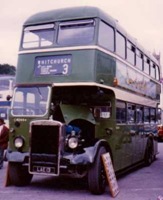 Vehicle reminder shot for this posting
Vehicle reminder shot for this posting
12/08/19 – 08:00
Thank you for a very interesting read. As a small boy I was struck by the sound of so many London Transport green double deckers. They would hunt at idle, getting faster and faster as they pulled away, until they finally got to 30MPH and the engines ran smoothly. Almost as though they had invented a missing cylinder, to cut back in only at speeds. With this amazing Internet, I’ve read that others noticed this too.
H Rogers
Quick links to the - Comments Page - Contact Page - Home Page

